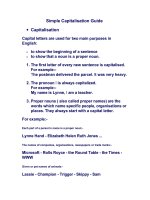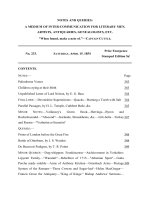- Trang chủ >>
- Đề thi >>
- THPT Quốc Gia
s3012 notes
Bạn đang xem bản rút gọn của tài liệu. Xem và tải ngay bản đầy đủ của tài liệu tại đây (756.61 KB, 3 trang )
STUDY NOTES
EPISODE 12: INTONATION
INTONATION
IELTS Tip
Intonation is a feature of pronunciation,
one of the criteria by which your Speaking
is assessed. Other features which define
this criterion include the following.
Be aware of and listen out for
English stress and rhythm patterns.
Practise these patterns by imitating
the speech of native speakers.
Pronunciation Features
Rhythm Number and length of stressed
syllables
Stress Syllable and sentence stress
Intonation Rising and falling tones of your
voice
Sounds Pronunciation of sounds
In the IELTS interview remember
to speak with a clear and strong
voice. Use a rising tone when
asking for clarification and a falling
tone when making a statement.
Speaking English naturally and fluently means speaking with English stress and
rhythm patterns. It is sentence stress that actually gives the English language its
rhythm. Try saying this sentence aloud.
I really admire my university professor.
How many stresses are there in the sentence?
1
'really ad
I
2
'mire my uni
3
'versity pro
4
'fessor
There are four strong stresses or beats.
Now, tap out the beats with your hands. The beat occurs on the strong stresses or
syllables.
a
1 and a
2 and then a
3 and then a
4
The stressed syllables occur at regular intervals while the unstressed ones in
between are said more quickly to keep the rhythm pattern of English.
Rhythm and sentence stress
English is a stress-timed language. This means that the timing between stressed
syllables in a spoken sentence comes at regular intervals regardless of the number
of syllables that may occur between the stressed ones. There may be one, two or
three syllables between the stressed ones as in the example above.
Stressed syllables occur on certain words within a spoken sentence. There are two
types of word in sentences:
•
•
content or information words
function or grammar words
Page 1 of 3
Content words are the important words in the sentence. They carry the meaning or
sense and are stressed.
Function words are the smaller words and give the sentence its structure and make it
grammatically correct.
The following table shows the types and examples of content and function words.
Content words – stressed
main verbs
nouns
adjectives
adverbs
negatives
demonstratives
wh-question words
Function words – unstressed
pronouns
prepositions
articles
conjunctions
auxiliary verbs
modal auxiliary verbs
admire, teach, know, write, think, dream, learn, talk, describe,
ask
professor, rhythm, knowledge, information, success,
experience
nice, good, talented, smaller, excited, famous, confident,
popular
really, quickly, surprisingly, creatively, environmentally-friendly
aren’t, can’t, don’t, no, not, none
this, that, these, those
who, what, when, which, why
I, you, he, she, his, her, it , we, our, they, their
at, by, for, from, in, of, on, to, with
a, an, the
and, but, or, for, because, as, while, although, so, yet
be, do, have
will, can, may, might, could, would, should, must
Rhythm patterns of a sentence are created using stressed and unstressed syllables.
The stressed syllables carry the strong beat. They are pronounced longer and
somewhat louder. Unstressed syllables are weak and pronounced using a short
vowel / / or schwa /4/.
Here are some examples of rhythm patterns. A phonetic transcription is given of the
unstressed syllables and/or words.
1.
He’s a tall man with dark hair.
He’s a /'h z4/
2.
You
/ju:/
beat 1
'tall
beat 2
'man with /w 3/
beat 3
'dark
beat 4
'hair.
You promised to help me with my pronunciation.
beat 1
'promised to
/m st4/
beat 2
'help me with my pronunci
/m w 3 ma pr4n nsi/
beat 3
'ation.
Page 2 of 3
3.
The city is full of great restaurants and pubs.
beat 1
'city is
/tij z/
The
/24/
4.
beat 2
'full of
/4v/
beat 3
'great
beat 5
'pubs.
My goal in life is to run my own business in five years’ time.
beat 1
'goal in
My
/ma /
beat 2
'life is to
/ zt4/
beat 3
'run my own
/ma j4 /
/ n/
5.
beat 4
'restaurants and
/tr nts4n/
beat 4
'business in
/n4s n
/
beat 5
'five
beat 6
'years’
beat 7
'time.
She’s the funniest person I’ve ever met.
She’s the
/1 z24/
beat 1
'funniest
/n j4st/
beat 2
'person I’ve
/s4n a v/
beat 3
'ever
beat 4
'met.
Communicating different meaning
It is important to know that placing a stronger emphasis on a word in an utterance
can also affect its meaning. In the single utterance below a different word is stressed
changing the meaning in each.
Stressed word
I’d like you to talk to her older sister.
I’d like you to talk to her older sister.
I’d like you to talk to her older sister.
I’d like you to talk to her older sister.
Meaning
The emphasis is on you, meaning that the person
is referring to you specifically, and not someone
else.
The emphasis is on talk, meaning that the person
doesn’t want you to write, email or take any other
action.
The emphasis is on older, meaning that it’s not the
younger or the oldest sister, but the older one that
the person wants you to talk to.
The emphasis is on the sister, meaning that it’s the
sister in particular that the person wants you to talk
to and not her brother.
Practising using rhythm and the stress patterns of English will help to improve not
only your speaking but listening skills as well. Because English is a stressed-timed
language not every word will be heard loudly and clearly. Being aware of this can
help overcome some difficulties when listening. Be careful also that particular
meaning may be conveyed when more emphasis is placed on a word.
Page 3 of 3









